Texas boasts a rich variety of deer species, ranging from the familiar White tailed Deer to exotic visitors like the Sika and Fallow Deer. These deer differ in size, coat patterns, antler shapes, and behavior, offering a fascinating glimpse into the state’s diverse wildlife. Whether roaming woodlands, grasslands, or private ranches, each species has unique adaptations that help them survive and thrive in Texas’ varied environments. Observing these deer provides valuable insights into their diets, social behavior, reproductive cycles, and interactions with humans. For hunters, wildlife enthusiasts, and nature lovers, understanding the types of deer in Texas is key to appreciating their role in ecosystems and promoting responsible conservation practices. This guide explores 8 prominent Texas deer species with pictures, identification tips, and interesting facts for each one.
1. White tailed Deer (Odocoileus virginianus)
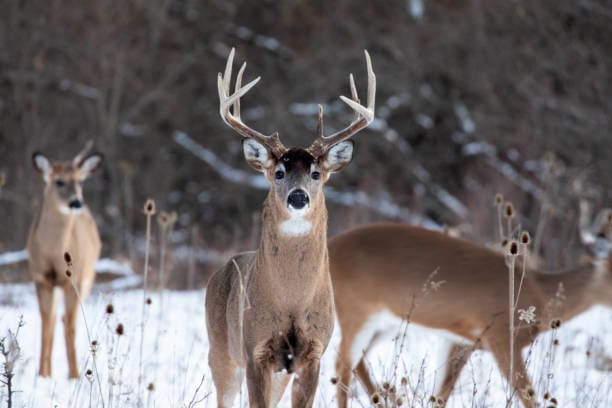
Physical Characteristics
The White tailed Deer is perhaps the most familiar big game animal in Texas. Bucks (males) often weigh between 150 and 300 pounds, with does (females) significantly lighter. Their coloration shifts with seasons: a rich reddish‐brown in summer, turning to a grayer, muted tone in winter. Their most iconic feature is the white underside of the tail: when alarmed, the deer raises that tail like a little flag, signaling danger. The antlers of bucks grow annually and can become quite impressive in older individuals.
Behavior
These deer are primarily crepuscular—most active at dawn and dusk—preferring cooler hours and more cover. They move with a combination of caution and grace: browsing quietly through woodlands, then bounding rapidly when startled. Bucks during the rut (breeding season) become more assertive, sometimes engaging in antler clashes and displaying louder vocalizations. Does tend to travel with their fawns in small family groups, whereas bucks may roam alone or in bachelor groups outside of the rut.
Habitat and Range
White tailed Deer occur throughout Texas—indeed, Texas boasts one of the largest populations in the nation. They inhabit forests, brushy canyons, agricultural lands, and even the suburban edges. In East Texas, they favor dense hardwood forests and river bottoms; in Central Texas, they are found in cedar, oak and live oak habitats; in parts of West Texas they utilize brushy canyonlands. Their adaptability to diverse habitat types has allowed them to thrive across the vast, varied Texan landscape.
Diet
White tailed Deer are browsers with a broad menu. In spring and summer they consume tender shrubs, leaves, wildflowers and the new growth of plants. During the fall, acorns, mast and corn (where available) become important high energy food items. In winter, when green browse is scarce, they shift to woody twigs and less‐palatable vegetation. Their feeding habits influence plant communities and their presence in agricultural landscapes may lead to human/deer interactions.
Reproduction and Life Cycle
The rut typically occurs in late fall—about November in Texas. Bucks pursue does, engaging in displays and occasionally sparring. After mating, the doe carries the fawns for approximately 200 days, giving birth in spring. Fawns are born with white spots that act as camouflage. Young learn to follow and stalk quietly with their mothers, becoming independent after several months. With proper conditions, individuals may live over 10 years, though many experience shorter lives due to predation, hunting and accidents.
Fun Facts / Distinct Traits
- Texas is home to more White tailed Deer than any other U.S. state—estimated at several million.
- Their tail flagging behavior is an effective visual alarm system that alerts other deer of nearby danger.
- They have excellent sense of smell and hearing, making them very difficult to approach quietly—yet this very wariness makes successful observation all the more rewarding.
Human Interaction
White tailed Deer are immensely important to Texas’s wildlife culture, recreation and economy. They are the quintessential game animal for hunters, and their sheer numbers and visibility also make them favorites for wildlife watchers and photographers. On the flip side, their presence in suburban or agricultural areas can lead to crop damage, vehicle collisions and other human/deer conflicts. Wildlife agencies like the Texas Parks & Wildlife Department manage populations, research habitat needs and regulate hunting seasons to maintain balance.
________________________________________
2. Mule Deer (Odocoileus hemionus)
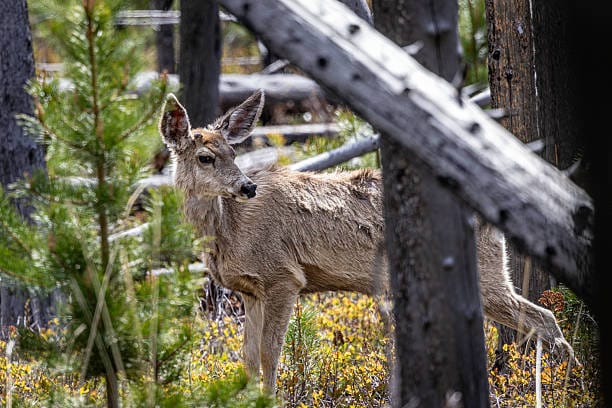
Physical Characteristics
The Mule Deer is named for its large, mule like ears. Adults typically weigh between 100 and 300 pounds and have a distinct grayish brown summer coat that may become duller in winter. Their tails are short and tipped in black. Bucks carry antlers that bifurcate—rather than branching off a single main beam, each tine splits into two, like a shallow “Y” shape, making them quite distinguishable from White tailed Deer.
Behavior
Mule Deer are somewhat more open terrain deer than their white tailed counterparts. They often move in open country, hills and plateaus, using their bounding leaps (sometimes called “stotting”) to navigate rugged terrain. They are alert and cautious, watching vividly for movement rather than relying solely on color. Bucks may form small bachelor groups outside the rut, while does and fawns tend to cluster in family units.
Habitat and Range
In Texas, Mule Deer are much less widespread than White tailed Deer. They are more common in West Texas—particularly in the Trans Pecos and Panhandle regions—where more open terrain and desert scrub exist. The Edwards Plateau and other arid or semi arid regions may also host mule deer populations. Their preference for open terrain and their fewer numbers in the state make sightings more special and less frequent.
Diet
Mule Deer are browsers that feed on shrubs, leaves, twigs and grasses. In their preferred terrain, they often consume mountain mahogany, sagebrush and other arid land vegetation. In spring when moisture allows, they’ll eat forbs and new shoots. Their diet reflects adaptation to drier, less productive habitats compared to more brushy environments frequented by white tails.
Reproduction and Life Cycle
The rut for Mule Deer generally occurs in the fall, with peak activity in November in some Texas regions. Bucks use antler displays and marking behaviors to attract does. After mating, does carry their fawns for about 200 days, with young born in late spring or early summer. Fawns stay with their mothers, learning forage and avoidance skills. Life expectancy in free ranging populations may reach 8 to 10 years, though many fall prey to predators or human hunting.
Fun Facts / Distinct Traits
- The Mule Deer’s large ears aren’t just for show—they help cool the deer and enhance hearing for survival in open terrain.
- The bounding “stotting” leap is a clever escape tactic: by launching all four feet at once, they create confusion for predators.
- Mule Deer often occupy higher elevations or more arid landscapes than white tails, giving them a distinct niche.
Human Interaction
While Mule Deer are hunted in Texas, their populations tend to be smaller and more localized, making them prized opportunities where they exist. Their presence in tougher terrain means wildlife watchers often get fewer views, but those views are memorable. Land management for mule deer habitat focuses on open space, browse availability and access to water—important considerations in arid zones. The contrast between mule deer and white tailed deer also fascinates wildlife enthusiasts interested in how different species adapt to Texas’s diversity of landscapes.
________________________________________
3. Axis Deer (Cervus axis)
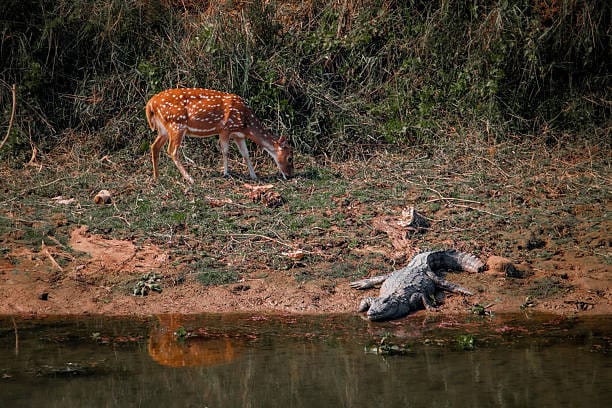
Physical Characteristics
The Axis Deer—also known as the Chital Deer—is an exotic species native to India and Sri Lanka, yet it thrives in parts of Texas following introduction. Adult males often weigh between 150 and 250 pounds, while females weigh between 90 and 150 pounds. Their coat is striking: a reddish gold with white spots that persist into adulthood (unlike many deer whose spots vanish with age). A dark dorsal stripe runs along the spine from neck to tail. Antlers in males often have three main tines and may reach impressive lengths for the size of the deer.
Behavior
Axis Deer are highly social and may form herds of several dozen to over a hundred individuals. These herds often include both sexes and young—unlike many native deer species where young care and male separation is more distinct. Interestingly, male axis deer may remain in herds year round rather than only joining during the rut. Their behavior can seem almost exotic: they produce bugle like bellowing calls during mating, and their social structure is more fluid than many North American deer.
Habitat and Range
Introduced into Texas around 1932, Axis Deer now exist in free ranging populations in many central and southern Texas counties, especially on ranches and private lands where conditions mimic their native habitat of mixed woodland and grassland. These animals prefer semi open terrain with adequate grassy undergrowth, water sources and cover. They steer clear of very rugged terrain and deep forest; rather, they thrive in broken woodlands and savannah like settings.
Diet
Axis Deer are primarily grazers with a preference for grasses less than about 10 cm high, though they will browse shrubs and forbs when grasses are less available. Their diet includes native grasses like switchgrass and little bluestem, and they may be observed feeding in agricultural fields and pastures. Their ability to thrive on grass and browse makes them well suited to the Texas ranch environment.
Reproduction and Life Cycle
Unlike many deer species that have a strict seasonal rut, Axis Deer may breed year round. This means females can produce fawns multiple times in shorter intervals under the right conditions. Gestation is approximately 7 to 8 months, with most fawns born in the spring and early summer. Because their breeding is not limited by strict seasons, their populations can expand quickly if unmanaged. Life span in the wild may reach around 10 years or more under favourable conditions.
Fun Facts / Distinct Traits
- Their spots remain prominent for life—an uncommon trait among deer.
- They’re described as one of the most beautiful deer species, with their golden coat and elegant form earning admiration from hunters and wildlife watchers alike.
- Because of their exotic origin and high fencing for game ranches, they draw attention from around the world and contribute significantly to Texas’s exotic game industry.
Human Interaction
Axis Deer play a special role in Texas’s wildlife and ranching landscape. They were introduced for sport and exotic harvesting, and many ranches manage them intensively. Their presence adds economic value through hunting, tourism and venison markets. At the same time, wildlife managers monitor their spread because they may compete with native species and affect vegetation. For the public, spotting an axis deer in the wild can feel like a safari in the deep South—unexpected, elegant and memorable.
4. Sika Deer (Cervus nippon)

Physical Characteristics
Sika Deer, originally from East Asia, are medium-sized deer with a compact, muscular body. Adults weigh 100–200 pounds, with males slightly larger. Their summer coat is reddish-brown, dotted with white spots that persist to varying degrees into adulthood. In winter, their fur darkens to a grayish-brown hue. Bucks grow antlers that are slender, usually with multiple tines, and shed them annually.
Behavior
Sika Deer are social animals, often forming herds ranging from a few individuals to dozens. They are mostly crepuscular, active at dawn and dusk, and use alarm calls and tail signals to warn herd members of danger. Unlike some native deer, sika deer may maintain group cohesion year-round, and males sometimes remain with females outside the rut.
Habitat and Range
In Texas, sika deer are mostly confined to private ranches and game preserves in East and Central Texas. They prefer mixed woodland, grassland edges, and areas near water sources, resembling their native habitats in Asia. Their adaptability to diverse environments allows them to coexist with other deer species in controlled areas. ([onxmaps.com](https://www.onxmaps.com/hunt/blog/hunting-deer-in-texas?utm_source=chatgpt.com))
Diet
Sika Deer are grazers and browsers. They consume grasses, forbs, leaves, and twigs. During the growing season, tender shoots and herbaceous plants are preferred, while in cooler months, they shift to woody vegetation and browse. Their varied diet helps them thrive in the subtropical and temperate Texas regions where they are introduced.
Reproduction and Life Cycle
The rut occurs in autumn, with bucks engaging in vocal displays and sparring to attract females. Females gestate for about 7–8 months, giving birth to typically one fawn in late spring. Fawns remain hidden for the first few weeks before joining the mother, gradually integrating into the herd. Sika deer can live over 10 years in captivity and slightly less in the wild due to predation and hunting.
Fun Facts / Distinct Traits
- Unlike most deer species, Sika males produce high-pitched whistling calls during the rut.
- They retain some spots into adulthood, giving them a visually striking appearance compared to many North American deer.
- In their native range, sika deer are highly vocal; Texas populations maintain some of these unique communication behaviors.
Human Interaction
Sika Deer are popular in Texas ranches for hunting, observation, and breeding programs. They attract wildlife enthusiasts due to their exotic appearance. Because they are not native, populations are usually managed to prevent habitat competition with native species. Responsible ranching ensures healthy herds while minimizing ecological impact.
________________________________________
5. Fallow Deer (Dama dama)
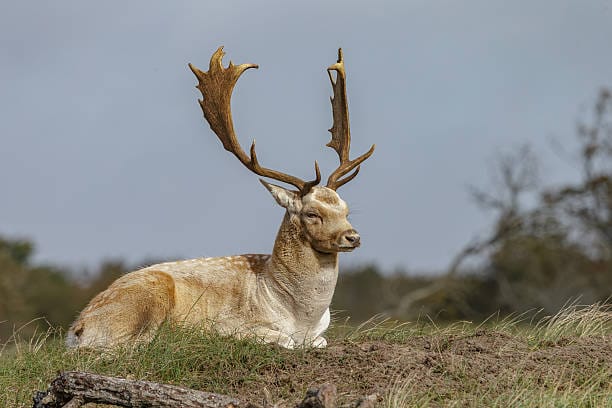
Physical Characteristics
Fallow Deer are medium-sized deer with a graceful build. Adults typically weigh 100–150 pounds. Summer coats are reddish-brown with prominent white spots, while winter coats turn darker and less patterned. Bucks have palmate (broad, flattened) antlers, unique among Texas deer species, which they shed annually.
Behavior
Fallow Deer are social, forming herds with multiple females and young, while bucks may form bachelor groups outside the rut. They are active mainly during dawn and dusk, using keen senses of hearing and smell to detect danger. During the rut, males display territorial behavior, vocalizations, and antler clashes to secure mates.
Habitat and Range
In Texas, fallow deer are largely restricted to ranches and game preserves. They favor lightly wooded areas, grasslands with scattered trees, and regions near water. Their adaptability allows them to thrive in managed habitats, where supplemental feeding and water sources are available. ([animalhype.com](https://animalhype.com/mammals/deer-in-texas/?utm_source=chatgpt.com))
Diet
Fallow Deer are both grazers and browsers. They feed on grasses, herbs, shrubs, leaves, and occasionally acorns. Supplemental feeding in ranch environments may include hay or grains. Their flexible diet allows them to adapt to both temperate woodlands and open pasture areas.
Reproduction and Life Cycle
The rut occurs in autumn, with bucks competing for harem groups. Gestation lasts approximately 230 days, producing one or two fawns in spring. Fawns rely on maternal care for the first few months before joining the herd. Fallow Deer may live up to 12–15 years in managed environments.
Fun Facts / Distinct Traits
- Fallow Deer bucks’ palmate antlers are striking and unlike the branched antlers of most North American deer.
- They are excellent swimmers, which helps them escape predators and navigate rivers in their habitat.
- Fallow Deer have a calm demeanor and are often used in game reserves for educational observation.
Human Interaction
Fallow Deer are primarily managed for hunting and wildlife observation in Texas. They provide aesthetic and recreational value while requiring controlled management to avoid competition with native deer species. Ranchers often monitor herd sizes, health, and breeding to maintain balanced populations.
________________________________________
6. Rocky Mountain Elk (Cervus canadensis nelsoni)

Physical Characteristics
Rocky Mountain Elk are among the largest members of the deer family in Texas, with males weighing 700–1,100 pounds and females 450–600 pounds. Their muscular bodies are covered in light brown to dark tan fur with darker necks. Males grow large, branching antlers annually, which can span up to four feet in width.
Behavior
Elk are highly social, forming large herds in winter and smaller family groups in summer. They are crepuscular, often vocalizing with bugling calls during the rut, which echo across valleys. Elk are strong runners and can leap obstacles easily, which helps them evade predators.
Habitat and Range
Elk in Texas are largely found in ranches and mountainous areas of West and Central Texas, particularly in areas mimicking their native Rocky Mountain environment. They favor open woodlands, meadows, and grasslands with access to water. Managed ranch populations ensure suitable habitat for breeding and grazing.
Diet
Elk are primarily grazers, consuming grasses, forbs, and woody vegetation. In winter, they may rely on shrubs and tree bark. Their large size necessitates high-energy diets, which they acquire by foraging extensively in the morning and evening hours.
Reproduction and Life Cycle
The rut occurs in fall, with males displaying antlers and vocalizations to attract females. Females gestate for about 8 months, giving birth to calves in late spring or early summer. Calves grow quickly and are weaned within a few months. Elk can live up to 15–20 years in protected environments.
Fun Facts / Distinct Traits
- Elk bugling calls are loud enough to carry over miles, helping males attract females and challenge rivals.
- They are the largest deer species in Texas, requiring careful habitat management.
- Elk herds have strong social structures, with dominant bulls leading during the rut.
Human Interaction
Elk are highly prized for hunting, wildlife watching, and conservation programs. Managed ranches provide controlled hunting opportunities, and elk contribute to the state’s ecotourism. Their presence also highlights habitat management needs and the balance between native and introduced species.
________________________________________
7. Carmen Mountains White tailed Deer (Odocoileus virginianus carminis)

Physical Characteristics
The Carmen Mountains White tailed Deer is a regional subspecies notable for slightly smaller size and lighter coloration compared to typical Texas white-tails. Bucks carry antlers with fewer tines but retain the signature white underside of the tail. Adults weigh between 120–220 pounds, with a reddish-brown summer coat that turns grayer in winter.
Behavior
This subspecies exhibits similar behavior to other white-tailed deer: crepuscular movement patterns, tail-flagging when alarmed, and maternal care of fawns. Bucks may become more solitary outside the rut, while does and fawns remain in small family groups.
Habitat and Range
Found in select ranches and natural preserves, the Carmen Mountains white-tail prefers open woodlands and brushy hillsides with abundant forage and water sources. Their range is limited compared to widespread Texas white-tails, emphasizing their ecological and conservational importance.
Diet
They browse and graze on a mix of grasses, forbs, leaves, and twigs. Seasonal diet shifts are similar to other white-tail subspecies, with acorns and mast consumed in fall and woody vegetation in winter.
Reproduction and Life Cycle
The rut occurs in late fall. Fawns are born in spring after ~200 days gestation. Fawns remain hidden initially, then follow their mothers into small family units. Life expectancy is around 10–12 years in managed populations.
Fun Facts / Distinct Traits
- They are a subspecies adapted to specific microhabitats in Texas, reflecting slight morphological differences.
- Tail-flagging behavior is highly developed for predator avoidance.
Human Interaction
These deer are mostly found on private lands and ranches, valued for hunting and conservation education. Their restricted distribution makes population management and habitat protection crucial.
________________________________________
8. Avery Island White tailed Deer (Odocoileus virginianus mcilhennyi)
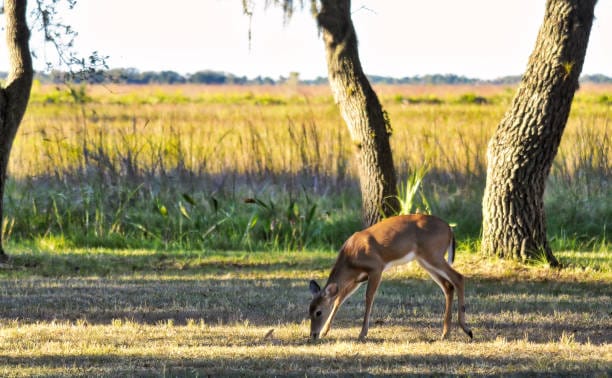
Physical Characteristics
Avery Island White tailed Deer are another specialized subspecies, slightly smaller than the standard white-tail and often darker in coloration. Bucks have moderately sized antlers with fewer tines. Adults weigh between 110–200 pounds and exhibit the classic white-tail signaling trait.
Behavior
Behavior mirrors other white-tails: crepuscular activity, cautious movement, family grouping of does and fawns, and solitary bucks outside the rut. Their alertness is heightened due to restricted habitat and potential human presence.
Habitat and Range
Primarily confined to specific ranches and preserves in Texas, these deer prefer woodlands interspersed with open grassland. Habitat management often includes supplemental food and water to support population health.
Diet
They are browsers and grazers, feeding on leaves, twigs, grasses, forbs, and acorns. Seasonal diet shifts occur as in other white-tail subspecies.
Reproduction and Life Cycle
Rut occurs in fall. Fawns are born in spring and integrate into maternal care groups. Managed populations help maintain health and genetic diversity.
Fun Facts / Distinct Traits
- They are part of Texas’s subspecies diversity, emphasizing the adaptability of white-tail deer to varied environments.
- Often used in research and conservation programs due to their restricted range and distinct traits.
Human Interaction
Avery Island white-tails are largely managed for private hunting, education, and conservation. Their presence underscores the importance of subspecies awareness and habitat stewardship in Texas wildlife management.
FAQ’s
1. What kinds of deer are in Texas?
Texas is home to several deer species, including White-tailed Deer, Mule Deer, and exotic species like Axis Deer, Fallow Deer, and Sika Deer on private ranches. White-tailed Deer are by far the most common.
2. How many deer are in Texas?
Texas has an estimated 5 million White-tailed Deer, making it the state with the largest deer population in the U.S.
3. What is the rarest deer in Texas?
The rarest deer are the exotic species like Sika Deer or Fallow Deer, which exist only on private ranches and are not naturally occurring in the wild.
4. What type of deer is in East Texas?
East Texas is dominated by White-tailed Deer. The area’s forests, rivers, and farmland provide excellent habitat for large, healthy bucks.
5. What is the biggest deer in Texas?
The biggest deer in Texas are trophy White-tailed Bucks. Some can weigh over 250 pounds and grow massive antlers, particularly in prime counties in central and south Texas.
6. What is the new deer species in Texas?
Axis Deer have been introduced to Texas relatively recently for hunting purposes. They are originally from India and are now found on private ranches across the state.
7. What is the deer capital of Texas?
There isn’t an official “deer capital,” but Hill Country and counties like Gillespie, Kerr, and Blanco are famous for trophy bucks and high deer densities.
8. Are there any Mule Deer in Texas?
Yes, Mule Deer are found in western Texas, especially in the Panhandle and Trans-Pecos regions, though they are far less common than White-tailed Deer.
9. What is the best tasting deer in Texas?
Most hunters agree that the White-tailed Deer offers the best-tasting venison in Texas. Properly field-dressed and aged, it is lean, tender, and flavorful.
10. Which part of Texas has the most deer?
Central and East Texas have the highest White-tailed Deer densities. Rolling farmland, forest edges, and brushy areas provide ideal cover and food.
11. What exotic deer are in Texas?
Texas has several exotic deer species on private ranches, including Axis Deer, Fallow Deer, Sika Deer, Blackbuck Antelope, and Red Deer.
12. How many types of deer are there in Texas?
There are at least five species of deer present in Texas: White-tailed Deer, Mule Deer, Axis Deer, Fallow Deer, and Sika Deer.
13. What deer is invasive in Texas?
Axis Deer are considered invasive because they can compete with native species for food and habitat if populations are not managed properly.
14. What is the 13 rule for deer in Texas?
The “13 Rule” refers to a hunting guideline for managing deer populations: hunters are often encouraged to harvest a balance of does and bucks, with the focus on maintaining healthy herd structures, but it is not a strict legal rule.
15. Why does Texas have so many deer?
Texas has a mild climate, abundant food, and large rural areas with few natural predators. Wildlife management programs and controlled hunting have also helped maintain high deer populations.
16. What is the most prominent deer species in Texas?
White-tailed Deer are by far the most prominent species in Texas, thriving across nearly every region of the state.
17. Why are Axis Deer in Texas?
Axis Deer were introduced to Texas for exotic hunting ranches. They reproduce quickly, adapt well to the environment, and provide unique hunting opportunities.
18. Is killing deer illegal in Texas?
No, hunting deer is legal in Texas with the proper license and during designated hunting seasons. There are strict regulations regarding bag limits, weapon types, and hunting methods.
19. Can I shoot an Axis Deer in Texas?
Yes, Axis Deer can be legally hunted on private ranches where they are stocked, following the property owner’s permission and Texas hunting regulations.
20. What preys on deer in Texas?
Natural predators of deer in Texas include coyotes, bobcats, mountain lions (in western areas), and occasionally bears. However, hunting and human activity are the main sources of mortality for adult deer.
21. How many acres to shoot deer in Texas?
There is no minimum acreage to hunt on private land in Texas, but most ranches that allow hunting are several hundred acres. Hunting on small parcels may require permission from neighbors due to safety concerns.
22. Can you keep a deer if you hit it in Texas?
If you accidentally hit a deer with a vehicle in Texas, you may keep it, but you must report the incident to local authorities and follow Texas Parks and Wildlife Department procedures for tagging and possession.
23. Can I hunt deer on my own property in Texas without a license?
No, you must have a valid Texas hunting license to hunt deer on your own property, even if it’s privately owned. Exceptions exist only for landowners or their immediate family under certain conditions, but license rules still apply in most cases.
Conclusion
Texas is home to an impressive array of deer species, from the familiar White tailed Deer to exotic introductions like the Sika and Fallow Deer. Each species brings its own charm, behaviors, and adaptations, highlighting the ecological diversity of the Lone Star State. Observing these deer—whether in ranches, preserves, or managed habitats—offers insight into their diets, reproductive habits, social structures, and interactions with humans. Understanding and appreciating these species not only enriches wildlife knowledge but also emphasizes the importance of responsible habitat management and conservation practices. From bugling elk to the subtle tail-flagging of white-tails, Texas deer truly showcase the wonder of North American wildlife.
Read more: 8 Types of Deer in California (Pictures And Identification)
